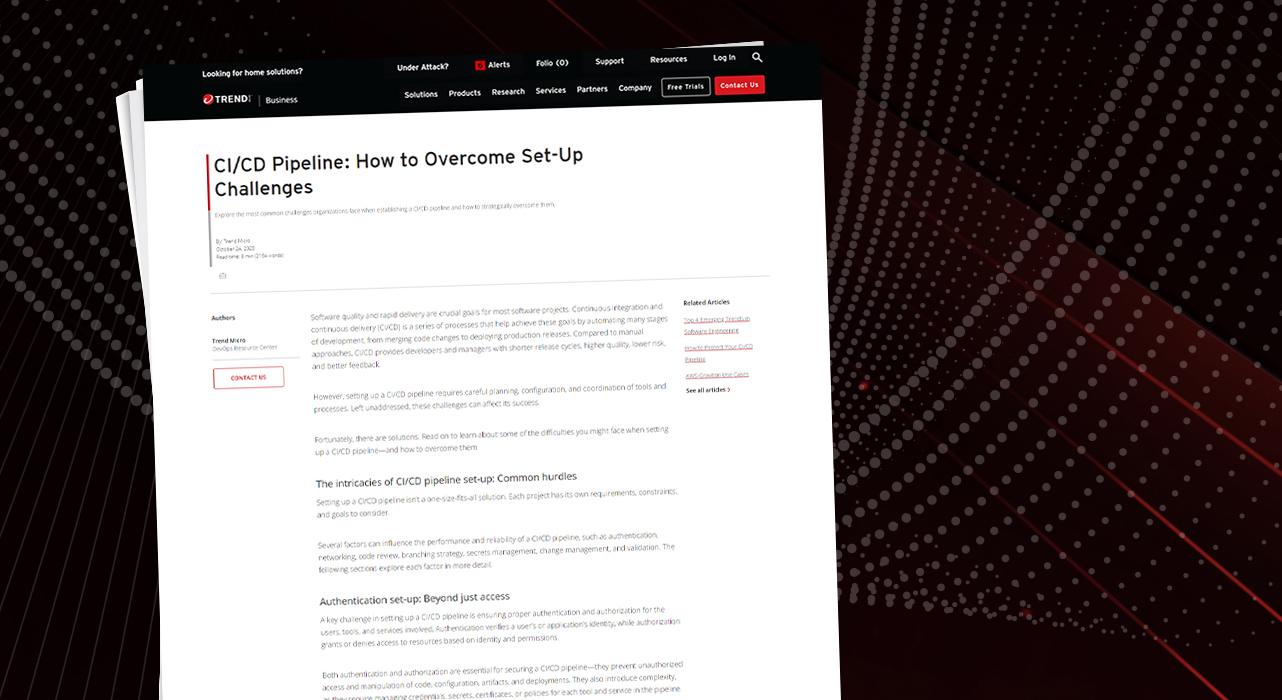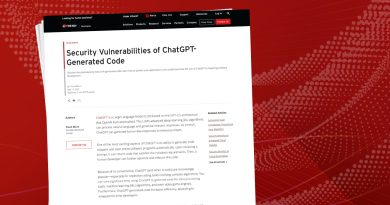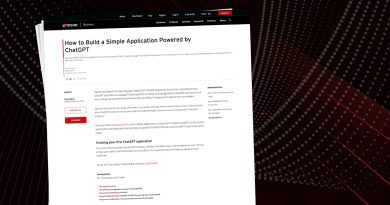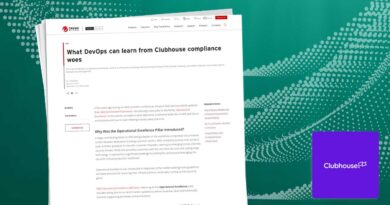CI/CD Pipeline: How to Overcome Set-Up Challenges


Software quality and rapid delivery are crucial goals for most software projects. Continuous integration and continuous delivery (CI/CD) is a series of processes that help achieve these goals by automating many stages of development, from merging code changes to deploying production releases. Compared to manual approaches, CI/CD provides developers and managers with shorter release cycles, higher quality, lower risk, and better feedback.
However, setting up a CI/CD pipeline requires careful planning, configuration, and coordination of tools and processes. Left unaddressed, these challenges can affect its success.
Fortunately, there are solutions. Read on to learn about some of the difficulties you might face when setting up a CI/CD pipeline—and how to overcome them.
The intricacies of CI/CD pipeline set-up: Common hurdles
Setting up a CI/CD pipeline isn’t a one-size-fits-all solution. Each project has its own requirements, constraints, and goals to consider.
Several factors can influence the performance and reliability of a CI/CD pipeline, such as authentication, networking, code review, branching strategy, secrets management, change management, and validation. The following sections explore each factor in more detail.
Authentication set-up: Beyond just access
A key challenge in setting up a CI/CD pipeline is ensuring proper authentication and authorization for the users, tools, and services involved. Authentication verifies a user’s or application’s identity, while authorization grants or denies access to resources based on identity and permissions.
Both authentication and authorization are essential for securing a CI/CD pipeline—they prevent unauthorized access and manipulation of code, configuration, artifacts, and deployments. They also introduce complexity, as they require managing credentials, secrets, certificates, or policies for each tool and service in the pipeline.
Follow the principle of least privilege such that each system only has the minimum level of access needed to do its job. Some ways to achieve it include:
- Eliminate hard-coded secrets—While hard-coded secrets are the easiest way to store authentication credentials, they’re the least secure. Instead, use a secret manager to store and manage secrets securely.
- Use service principals or managed identities—Service principals and managed identities are headless security principals that you can assign specific roles and permissions without using passwords or keys.
- Use role-based access control (RBAC) or attribute-based access control (ABAC)—RBAC and ABAC allow developers to assign granular roles or attributes to users or services, granting or denying access based on those roles or attributes. This makes it easy to narrowly scope access to only necessary elements for a CI/CD tool’s role in the pipeline.
Getting authentication right when setting up a CI/CD pipeline helps ensure its secure operation over time.
Networking nuances: Ensuring seamless data flow
Networking is critical for the effective functioning of CI/CD pipelines, but often isn’t emphasized enough. It acts as the circulatory system that allows data to flow securely between various components, from code repositories to build servers and from testing environments to deployment platforms.
Poorly managed networking leads to challenges like delayed deployments, sluggish performance, and even complete pipeline failures. These essential practices can mitigate the risks:
- Use VPNs—Establish secure and encrypted connections between different networks or regions to ensure data integrity and confidentiality.
- Use load balancers—Evenly distribute traffic and workload among multiple servers in the pipeline to optimize resource usage and prevent service interruptions.
- Use firewalls—Control and filter incoming and outgoing network traffic to prevent unauthorized access and enhance security.
- Frequently monitor—Continuously analyze network performance using specialized tools to detect and fix issues before they escalate.
- Perform network testing—Use specialized tools to simulate real-world conditions and stress loads, helping to uncover performance or security issues.
Well-executed networking is the backbone of a CI/CD pipeline. Poorly executed networking leads to flaky, unreliable pipelines.
Code review: Ensuring quality at every step
Code review is another vital CI/CD pipeline checkpoint that usually comes after initial automated CI checks but before most other pipeline stages. Factors to consider when implementing code review include:
Code metrics—Measuring code metrics like test coverage, cyclomatic complexity, and coding standards can provide valuable insight into code quality and potential issues. However, metrics can flag problems but don’t always catch their absence. For example, poor code can still have high test coverage.
- Automated assistance—Automated analysis tools like linters and static analyzers act as the first line of defense, efficiently scanning code to flag common issues. These tools enable human reviewers to focus on nuanced aspects that may elude automated checks.
- Honest dialogue—Effective communication between reviewers and developers is paramount. Leveraging platforms that facilitate smooth dialogue streamlines the review process, ensuring feedback is clear and actionable.
- Streamlined workflows—A well-documented review workflow accelerates the process without sacrificing thoroughness. It provides clarity on expectations and steps, making reviews efficient yet comprehensive.
Including a manual quality checkpoint like code review in an otherwise automated CI/CD pipeline provides a chance to catch subtle bugs before they reach production.
Crafting the right branching strategy
Branching strategy impacts CI/CD pipeline design by influencing how code moves from development to production. Branching models like GitFlow, GitHub Flow, and trunk-based development bring distinct advantages and challenges. These complexities can escalate on large teams, leading to merge conflicts and stale branches.
To create an effective branching strategy, implement the following:
- Naming conventions—Adopt a consistent naming scheme for branches to minimize confusion. For instance, feature branches could be named “feature/XYZ” and bug fixes as “bugfix/XYZ,” making it clear what each branch contains.
- Branching tools and strategic alignment—Use tools and plugins to automate repetitive branch management tasks. Pair them with a branching model that fits your project’s pace and size. For example, a fast-paced project might benefit from trunk-based development, while long-term projects with distinct release cycles may find a Gitlow workflow more suitable.
- Access control—Limit who can make changes to specific branches with branch protection rules, reducing the chance of erroneous or malicious changes.
Thinking about what best meets your team’s needs will help you craft a branching strategy that makes your CI/CD pipeline more efficient and addresses the challenges of multi-developer environments. This ultimately results in smoother workflows and better code quality.
Safeguarding secrets
Securing sensitive information like passwords and API keys is crucial to your CI/CD pipeline’s integrity. These secrets are necessary for tasks like authentication and encryption, but a single breach can derail your entire deployment pipeline.
Secrets originate from various sources, such as environment variables and configuration files, and interact with pipeline components—from code repositories to deployment tools. Unprotected secrets are vulnerable to breaches and may accidentally leak into logs, making secret management complex. But several strategies can help:
- Centralized storage—One of the most effective ways to manage secrets is using a specialized vault that provides consolidated storage. This centralization eases the burden of managing permissions and enables better secret usage tracking.
- Encryption—It’s also crucial to encrypt these secrets when they are stored (at rest) and in transit. This encryption provides a secondary line of defense, making unauthorized access significantly more challenging.
- Limited access—You should further minimize risks by restricting secret access solely to the services and personnel who absolutely need them. This targeted access control reduces the chances of accidental exposure or misuse.
- Auditing and monitoring—Ongoing audits and real-time monitoring are your allies in promptly detecting and dealing with unauthorized access or anomalies.
- Rotation policies—Finally, consider automating the rotation of secrets to mitigate long-term risks. Frequent changes can limit the damage from leaks, making the task less labor-intensive.
Together, these strategies help keep your pipeline’s secrets safe. They also enhance security and streamline operational efficiency, making your development and deployment process resilient against unauthorized access and potential breaches.
Change management in CI/CD
Effective change management is vital for a CI/CD pipeline’s success. It governs not just code but also configuration changes and dependencies, with diverse impacts on functionality, performance, and security.
Yet, implementing change management in an agile environment comes with its own set of challenges. You’re coordinating between team roles—developers, testers, managers—and sometimes even executives or end users. To maintain both rigor and agility, consider a few guidelines:
- Maintain clear documentation—Keep an up-to-date changelog. This ensures everyone is on the same page, avoids misunderstandings, and promotes effective communication.
- Streamline the approval process—Use an efficient system for processing change requests and approvals. This adds a layer of scrutiny without becoming a bottleneck, ensuring quality without sacrificing speed.
- Use timely notifications—Opt for real-time alerts to keep critical players informed, empowering quick decisions and actions, thus adding a layer of resilience to your pipeline.
- Facilitate easy rollbacks—Provide a straightforward way to undo problematic changes, which minimizes downtime and maintains pipeline integrity.
Striking the right balance in change management mitigates risks and prevents costly mistakes. It simultaneously ensures that delivery speed remains high, contributing to a robust and efficient CI/CD process.
Validating the pipeline: Testing CI/CD itself
A CI/CD pipeline is more than just a tool for delivering software. It’s also a complex system that requires validation to verify its functionality and reliability. Beyond ensuring that the pipeline doesn’t introduce errors or issues in the software delivery process, validation should also enhance the quality and speed of the software you ship.
Validating a CI/CD pipeline involves numerous challenges and considerations from testing software features. Unlike software features, a CI/CD pipeline consists of various interconnected stages, each with unique requirements. The pipeline is often a mix of multiple tools, from version control systems to build and deployment tools, each with specific nuances and potential pitfalls. Furthermore, numbers like deployment speed or build failure rates can mislead users if they don’t account for other factors like code quality or security vulnerabilities.
A well-crafted validation approach includes:
- Automated checks—Automation can continuously monitor the CI/CD system for configuration drift, unauthorized changes, or other inconsistencies that can cause pipeline failure.
- Manual oversight—Human oversight is also crucial to evaluate the impact of these metrics on business goals. Automated checks provide plenty of data but don’t explain its meaning.
- Monitoring tools—Configured to trigger alerts based on predefined conditions, these tools allow immediate intervention. A centralized dashboard can synthesize data from various sources, providing a comprehensive view of pipeline health, from code quality metrics to deployment speeds.
By including automation and human oversight in the CI/CD validation process, you validate its technical outcomes and business objectives.
Selling the value: Communicating CI/CD benefits to stakeholders
A CI/CD pipeline isn’t just a technical asset—it’s a business enabler. Communicating its value effectively to stakeholders is crucial for securing investment and organizational commitment. The goal is to make the abstract tangible and the technical relatable, all while building a compelling business case for CI/CD.
However, you may find communicating that business case difficult for several reasons.
First, you have diverse stakeholders. You’re not just talking to engineers. Stakeholders range from developers and testers to C-suite executives and even customers. Each has a different perspective and set of priorities.
Additionally, there are multiple dimensions of value. The benefits of CI/CD are often highly role-specific. Developers may focus on code integration, QA teams on automated testing, and business leaders on quicker time-to-market and cost savings. This makes it challenging to communicate a unified value proposition that appeals to all stakeholders.
You must also measure non-technical stakeholders’ return on investment (ROI). Often, conveying the value of a CI/CD pipeline involves complex metrics that aren’t inherently meaningful to non-technical stakeholders. The challenge lies in translating these metrics into tangible business outcomes.
Fortunately, a few key activities can help you communicate the value of CI/CD and secure the buy-in you need:
- Craft a value proposition—Develop a concise statement that encapsulates the primary benefits of CI/CD, tailored to resonate with each stakeholder group. This sets the tone and direction for more detailed conversations.
- Quantify and compare—Use performance metrics to showcase tangible improvements that CI/CD brings. Comparative data proves persuasive, especially those measuring performance before and after CI/CD implementation.
- Leverage success stories—Real-world examples and testimonials can add credibility and emotional weight to your pitch. Share stories that depict how CI/CD has solved problems or delivered value in scenarios relevant to your stakeholders.
By strategically tailoring your communication approach to each stakeholder group and substantiating your claims with data and real-world success stories, you don’t just make a case for CI/CD—you build a strong argument for transforming how your organization approaches software development.
Summary
Setting up a CI/CD pipeline isn’t a one-time task but a continuous process—one that requires careful planning, execution, and monitoring. From ensuring your network supports your CI/CD pipeline to lax authentication processes or other mismanagement issues that can create hiccups, organizations face several common hurdles when implementing a CI/CD pipeline.
Fortunately, you can overcome these challenges with strategies that include maintaining thorough authentication practices, securing networks, incorporating code reviews and validation processes, using a branching strategy, implementing change and secrets management, and valuing communication.
While this might seem like a long list, consider that these practices help you set up a CI/CD pipeline that is secure, reliable, efficient, and valuable for your software projects. An adequately set up pipeline stays out of the way, freeing engineering teams to spend their valuable time elsewhere.
Read More HERE



